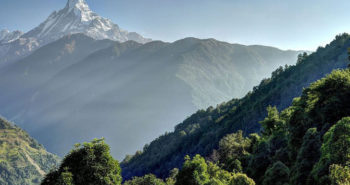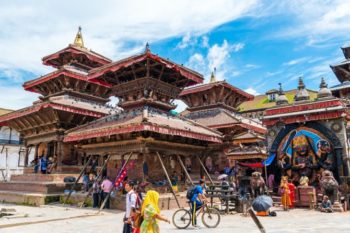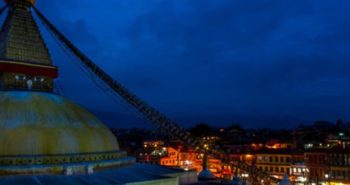10 Things You Should Know About Kanchenjunga Trekking
1. Kanchenjunga Trek Permit
You need to obtain the special Restricted Area Entry Permit for Kanchenjunga. It will cost USD 10 per person, per week. The permit start from Tapethok VDC and ends at Yamphuding VDC. The permit should be issued in Kathmandu at the Immigration Department before you depart.
A minimum of two trekkers, a guide, and a registered agency is needed to obtain the permit. You also need to obtain a Kanchenjunga Conservation Area Permit. This can be obtained either in Kathmandu or directly at the checkpoint on the trek. Check the detail of necessary permits for Kanchenjunga trekking.
2. Kanchenjunga Trek Itinerary
There are three routes and you can trek to Kanchenjunga South Base Camp or to Kanchenjunga North Base Camp or cover both base camps. The Kanchenjunga Circuit Trek, which covers both base camps and you can do it clock wise or anti-clockwise. The minimum number of days required is 16 and maximum is 23 – starting from and returning to Kathmandu. Check the most recommended itinerary for Kanchenjunga trek.
3. Kanchenjunga Trek – Getting There
Taplejung is the starting point of any Kanchenjunga Trek. You can take a flight to Suketar and hike down to Taplejung. This is the most convenient way to get to Taplejung from Kathmandu. Goma Air, Tara Air and Nepal Airlines schedule weekly flights. Check with the airlines for availability. Weight limit is 20 kilo per person for foreigners and 10 or 15 kilo per person for Nepali passengers. Bhadrapur is the other nearest airport to Taplejung. There are daily flights to Bhadrapur from Kathmandu. You can ask us to book the flight to and from Bhadrapur here. From Bhadrapur it is a ten hour drive to Taplejung, deluxe buses leave from Birtamod every morning or you can rent your own vehicle.
4. Kanchenjunga Trek Accommodation
You can choose accommodation in Taplejung and Bhadrapur. A room with air conditioning cost up to 35 USD and a normal fan room are as cheap as 5 USD. While trekking you do not have any choice or option with regards to accommodation. In Lhonak, Sele Le and Ramche there is not even a toilet in the teahouses. Check standard and price for accommodation in Kanchenjunga.
5. Kanchenjunga Trek Food
Food is very basic in Kanchenjunga. Dal bhat, thukpa, chowmein and instant noodles are the most common food. In a few places you will be able to get macaroni, pasta and spaghetti. Check the availability, menu and price of food in Kanchenjunga Circuit.
6. Kanchenjunga Trek Best Trek Time & Packing List
Elevations range from 200m to 5,175m. It is very hard to find the actual balance in term of weather, temperature and view. Check the best time for the Kanchenjunga trek. Also check the recommended packing list for the Kanchenjunga Circuit.
7. Kanchenjunga Trek Difficulty
With basic teahouse and hut accommodation, Kanchenjunga is a great trek with a teahouse options. Facilities are, however, very basic. Here is a nice in depth Kanchenjunga circuit trek report with all the details of trekking. Also, check Kanchenjunga travel guide for other useful information.
8. Kanchenjunga Trek Elevations and Distances
Elevations vary widely along the trail. Commercially available maps all have different elevations for the same places! Check an online Kanchenjunga trek map.
The Kanchenjunga north to south trek was recently tracked in May 2016 using a Delorme Reach Device. Check the correct elevations of the Kanchenjunga trek route with accuracy adjustments.
9. Kanchenjunga Trek Post- Earthquake
Kanchenjunga is in the eastern most boundary of Nepal, sharing a border with both Sikkim and Tibet. There is not any significant affect from the earthquake in Kanchenjunga.
10. Kanchenjunga Trek Side Trip
Normally two rest days are allocated for the Kanchenjunga Trek. On the north side there are two places for acclimatization. You can allocate a rest day in Ghunsa and Khambachen. While on the south side you can have an acclimatization day in Yamphuding.
Ghunsa Side Trip
A ridge above the Ghunsa Monastery is a perfect morning hike for acclimation. The view over Ghunsa and Phole is breathtaking with prayer flags flapping in the wind. You can also view some mountain peaks from the top.
Khambachen Side Trip
You can hike toward Jannu Base Camp from Khambachen or toward the Nupchu Khola Valley. The hike to Jannu Base Camp is rewarding with views of the Moraine Glacier. First you need to cross the river, then find the temporary bridge or wade though knee-deep water. Relatively easy, but extremely cold! A new small basic hut is being built in the area near Jannu Base Camp for Kirat people for their religious gathering, once a year.
Yamphuding Side Trip
Magical Nepal is not sure whether you can make it in one day or not but there is an awesome trip to Timbua Pokhari from Yamphuding. Ask locals for an update about the trail.



2 Comments
June 9, 2019 at 9:27 am
Hey Pradeep,
Hope you are doing well.
I am Mitesh from Mumbai and planning to trek Kanchenjunga this year by November.
Need your suggestion and guidance for this trip. I want to cover Indian side base camp and also seeking your suggestion for skydiving from Kanchenjunga if any available.
June 19, 2019 at 1:03 pm
Hi Mitesh,
I do not have any information about trekking Kanchenjunga from Indian side. And so far I know from Nepal side there is no such availability of sky diving in Kanchenjunga Area.
Regards Pradeep,